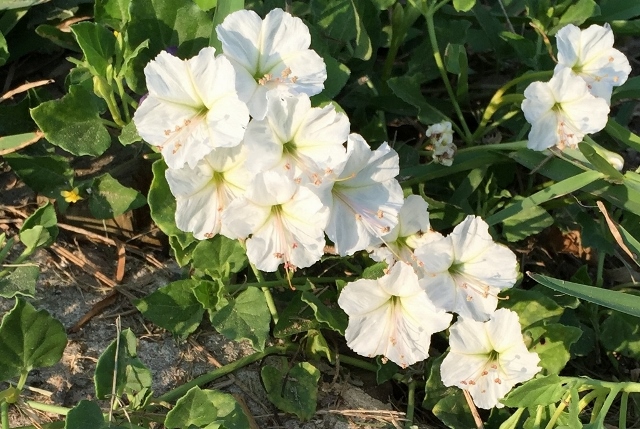By Anita Westervelt, Texas Master Naturalist

Berlandier Trumpets (Photo by Anita Westervelt)
At dusk, white flowers glow with their own special drama. Some seem to float like tiny alien spaceships in a dark, terrestrial sea. During the day, white-flowering plants suspended among a diversity of green leaves generate a cool, peaceful visage in the summer’s heat.
In descending order of height, here are a few native white-flowering plants for a magical garden. The plants provide heavy nectar in the daytime for butterflies and other beneficial pollinators and a garden-glow-at-night view from a porch or patio.
Frostweed, or Crownbeard, Verbesina microptera. An excellent butterfly nectar plant, frostweed blooms summer to fall. The flower heads can get as big as a hand on sturdy, woody, winged stalks. These perennials can reach to six feet. The plants appreciate an occasional watering. Cut them back to about six inches after flower heads have gone to seed. For fun, shake the dried heads into a large paper sack and collect the seeds to share. The plants also multiply by short rhizomes. The roots of this plant can be dug up and shared, too. Amazingly, they can take some brutal handling, even left in a bucket with a bit of water for a few days before transplanting. Survival rate is quite high. Water in well to establish.
White Plumbago or Leadwort, plumbago scandens, is an important butterfly nectar plant that will sprawl but reward you with white blooms spring through fall. It is an ideal species to train on a support and easily re-seeds.
Nicotiana, or Fiddleleaf Tobacco, Nicotiana repanda. An unusual native plant, the large, tobacco-leaf-shaped basal leaves form a big rosette on the ground. From that, thin, but sturdy, crooked stems shoot up with smaller, alternating leaf groupings. At the upper part of the stems, small five-point star-shaped white tubular flowers stand in the essence. The quarter-sized stars, even during the daytime, appear to be suspended in air. Butterflies and an occasional Hawkmoth (largely mistaken for hummingbirds) nectar from nicotiana flowers. Flowers open in the evening and begin to droop in the daylight. This plant is not prevalent for purchase, but very likely is already in your yard in the shade of a tree. This is another plant that you can collect and share seeds.
Heliotrope, Heliotropium angiospermum, also called scorpion’s tail because tiny white flowers make delicate arcs at the tips of the plant. During the day, this compact bush is busier than a truck stop attracting many different species of small butterflies like blues, skippers, patches and checkerspots. New shoots are easily potted up or transplanted in late winter.
Coastal Germander, Teucrium cubense, has delicate white blooms that fill multiple dark green leafy spires. The tiny orchid-like blooms are nearly as small as the leaves but no less attractive to butterflies. The little bushy plants can grow to about 30 inches and bloom all year, even during a hot, dry summer. This plant makes a nice edging for a garden or patio.
Texas Frog Fruit, Phyla nodiflora, and Silky Leaf Frog Fruit, Phyla strigulosa, are interestingly named tiny plants that pack a powerful source of nectar to dozens of species of small butterflies. Frog fruit is an excellent ground cover without being aggressive. White petals circle a purple center blooming spring through fall with leaves that stay green all winter.
Berlandier Trumpets, Acleisanthes obtusa, is an upright to climbing perennial that can grow up tree trunks or sprawl vine-like on the ground. It grows in sandy and clay soils and can be found growing in cracks of driveways, along sidewalk edges and between the slats of retainer walls. The fragrant, trumpet-shaped flowers open at night between April and December. Bright green, heart-shaped leaves of new growth form a healthy-looking clump. Get up early in the morning to see the flowers as they bloom in the evening and close in the sun. The stamen anthers are pink and from a distance give the blooms a white and pink polka-dot appearance. The blooms attract hummingbird moths and other night-flying moths. Mostly difficult to transplant, it can be propagated from root divisions or semi-hardwood cuttings. Or left to nature to distribute seeds, it will pop up in surprising locations.
For a list of Valley native growers, visit www.rgvctmn.gov (Interesting Links, RGV Plants).
